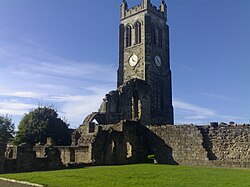Kilwinning Abbey
 |
|
| Monastery information | |
|---|---|
| Order | Tironensian |
| Established | circa 1162 - 1168 |
| Disestablished | 1592 |
| Mother house | Kelso Abbey |
| People | |
| Founder(s) | Richard de Morville |
Kilwinning Abbey is a ruined abbey located in the centre of the town of Kilwinning, North Ayrshire.
The ancient name of the town is 'Segdoune' or 'Saigtown', probably derived from 'Sanctoun', meaning the 'town of the saint'. Saint Winning's festival was on 21 January and the year of his arrival from Ireland was 715 AD. The site for the first church and later the abbey was revealed to Saint Winning by an Angel in a vision.
Kilwinning was a Tironensian Benedictine monastic community, named after Tyron in the diocese of Chartres. The abbey was dedicated to Saint Winning and the Virgin Mary, and founded sometime between 1162 and 1188 with monks coming from Kelso. The patron is not known for certain, but it may have been Richard de Morville, Lord of Cunninghame and Great Constable of Scotland, perhaps with the backing and assistance of King William of Scotland. A story developed that another Sir Richard de Morville who was involved in the murder of Thomas a Becket was the founder of the abbey, however despite the likelihood of the families being the same, the dates of the events make this connection impossible. A connection that does exist is the founding of Arbroath Abbey in 1178, also a Tironensian abbey, in memory of Thomas a Becket by William the Lion (1165–1214).
The abbey, located far away in the west at a distance from the core of Lowland Scotland, is not very well recorded, and few of its records have come down to posterity as the chartulary has been destroyed or lost. In 1571 the records are said to have been carried away by a furious horseman, following an attack upon the abbey. In 1591 William Melville took legal action against Jean Blair or Cunninghame, widow of Alexander Cunninghame to force the return of the records, but they were not forthcoming.Timothy Pont in the 17th century claimed to have studied the abbey's chartulary, possibly at Eglinton Castle; certainly the seal of the monastery was preserved at the castle. At the beginning of the 17th century they had been seen in the possession of the Earl of Eglinton until they were loaned to the Ayrshire and Galloway Archaeological Society who were preparing a publication that was never published.
...
Wikipedia
